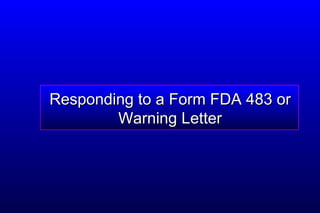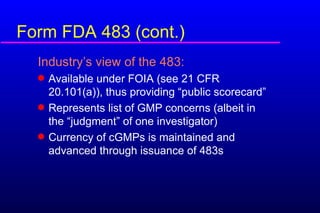Responding To A 483and Warning Letter
- 1. Responding to a Form FDA 483 or Warning Letter
- 2. Introduction Main points of discussion: Overview Form FDA 483 Responding to the FDA 483 Warning Letter Responding to a Warning Letter Common Mistakes
- 3. Overview Form FDA 483 created in 1953 by addition of Section 704(b) to FD&C Act Intended to eliminate possibility of FDA action against a firm without prior notice Notice of Inspection (Form FDA 482) was also mandated
- 4. Form FDA 483 Provided to assist firms in complying with Acts enforced by FDA List of objectionable conditions and practices which indicate violations Presented at conclusion of inspection (close-out) Close-out provides opportunity for clari-fication & final review (FOI releasable)
- 5. Form FDA 483 (cont.) FDAŌĆÖs view of the 483: Specific feedback on actual industry practice to assist in voluntary compliance Means for FDA to comply with the require-ment of Section 704(b) Establishes a background of prior warning notwithstanding requirement of strict liability
- 6. Form FDA 483 (cont.) IndustryŌĆÖs view of the 483: Available under FOIA (see 21 CFR 20.101(a)), thus providing ŌĆ£public scorecardŌĆØ Represents list of GMP concerns (albeit in the ŌĆ£judgmentŌĆØ of one investigator) Currency of cGMPs is maintained and advanced through issuance of 483s
- 7. Responding to the FDA 483 Verbal Response At close-out, prior to issuance, is the opportunity to clarify misunderstandings Deficiencies corrected during inspection can and should be pointed out Not a substitute for a full written response
- 8. Responding to the FDA 483 Written Response Respond quickly (10 to 15 days), even if initial response will be preliminary Understand significance of observations relating to product quality Acknowledge observations and describe corrections being made Immediate corrections if possible, otherwise set realistic time frames
- 9. Responding to the FDA 483 Written Response (continued) Provide assurance when possible that quality of distributed product (public safety) is not a concern Address all deficiencies; provide plan of action with target dates; always expect FDA follow-up Emphasize that ŌĆ£globalŌĆØ or ŌĆ£systemicŌĆØ issues have been addressed
- 10. Example of a Good Response Inspectional Observation Instruments 12, 16, and 382, which were in use during the manufacture of Lots 5, 6, and 7 of Product X had exceeded due dates for their next scheduled calibrations GMP requirement: 21 CFR 211.68(a)
- 11. Example of a Good Response Elements of Successful Written Response: Instruments were calibrated and found to be within limits (records attached) Usage in manufacture of Product X has no effect on quality Calibration program to be reviewed to assure no other such instances Review of program along with any needed corrections will be completed in 60 days; documentation will be submitted
- 12. Example of a Good Response Key Features of Each Element Immediate corrections made when possible and adequately documented Effect of deviation on product quality is objectively assessed Systemic and/or global ramifications of observation are addressed Target date set for ongoing actions, with promise to submit documentation
- 13. Warning Letters Considered an advisory action Intended to elicit voluntary correction Establishes background of prior warning Should only be issued for violations of ŌĆ£regulatory significanceŌĆØ Published under FOI immediately
- 14. Warning Letters Violations specified in a Warning Letter represent concerns not only of an investigator, but of District and/or Center compliance officers Possible repercussions: recall, seizure, injunction, monetary fine, debarment, disqualification, license suspension or revocation, prosecution, denial of access to U.S. market (e.g., foreign API suppliers)
- 15. Responding to a Warning Letter Notify top management of the scope of the problem Contact the District Director or Compliance Officer Provide written response Acknowledge obligation to comply with law Discuss impact on product quality Global and/or systemic corrections Corrective actions and timetable for completion
- 16. Requesting to Meet with FDA Key aspects of meeting: Ensure common understanding of GMP concerns Verify adequacy of proposed corrections Reveal if further action by FDA is planned Achieve agreement on how to proceed Provide a written summary, including any clarifications and additional commitments Provide periodic updates of progress
- 17. Avoiding Unnecessary Problems DonŌĆÖt set unrealistic goals DonŌĆÖt blame everything on a lack of training DonŌĆÖt trivialize product complaints DonŌĆÖt fail to proofread correspondence DonŌĆÖt cite other firmsŌĆÖ practices DonŌĆÖt fail to implement promised corrections
- 18. The Only Proven Technique for Avoiding Enforcement Actions Establish effective Quality Systems Establish means define , document (in writing or electronically), and implement (Reference: 21 CFR ┬¦ 820.3(k))
- 19. GMP Inspections ŌĆö Key References 21 CFR Parts 211, 820, 803, 806, et al. Compliance Programs Inspectional Guidance Mandatory Recordkeeping May 16, 2002 (67 FR 34939) ŌĆö pharmaceuticals Mandatory Recordkeeping, Feb 19, 2004 (69 FR 7755) ŌĆö devices Court decisions, e.g. U.S. v Barr Laboratories
- 20. GMP Inspections ŌĆö Key References Warning Letters EIRs and 483s releasable under FOIA CDER (Division of Manufacturing and Product Quality), CDRH, CBER Guidance Documents Compliance Policy Guides IOM, RPM, FMDs
- 21. Enforcement Statistics 900 1,154 1,032 755 545 737 Warning Letter 25 36 27 13 25 10 Seizure 3,736 3,716 4,563 5,025 4,627 4,670 Recall 8 9 12 15 22 13 Injunction 211 353 360 271 206 196 Conviction FY 99 FY 00 FY 01 FY 02 FY 03 FY 04
- 22. Recalls for Fiscal Year 2004 By FDA Center Source Of Data: Division of Compliance Management and Operations, OE Total Recalls = 4,670
- 23. Warning Letters for Fiscal Year 2004 By FDA Center Source Of Data: Division of Compliance Management and Operations, OE Total Warning Letters = 737
- 24. Seizures for Fiscal Year 2004 By FDA Center 7 2 1 Source Of Data: Division of Compliance Management and Operations, OE Total Seizures - 10
- 25. Summary Compliance is the ultimate objective Protection of public health through compliance with laws and regulations should be a mutual objective Compliance can require a significant financial commitment Effective communication is vital
Editor's Notes
- #2: Provide biographical sketch if necessary or desirable.
- #7: Although theoretically releasable immediately upon issuance, request is predicated on knowledge of the 483ŌĆÖs existence.
- #8: Personnel at firms can become as knowledge-able about the regulations as FDA investigators and will always have more knowledge about their own firmŌĆÖs operations. If an observation seems inappropriate, the close-out is an opportunity for discussion. Turbo EIR is a mechanism for increased consistency and accuracy.
- #9: The Medical Device Warning Letter Pilot is no longer in effect (adequate response could previously obviate issuance of W/L).
- #11: Companies should feel free to challenge the inspectional team to explain the basis for the observation. Convincing information that invalidates the observation should result in its removal. Any such discussions should focus on issues and not descend to a personal level.
- #14: Warning Letter Reference Guide and Regulatory Procedures Manual define violations of regulatory significance as circumstances, which if uncorrected, would lead to enforcement action. Multiple Warning Letters are not to be issued.
- #17: It is imperative that you understand why FDA considers the GMP concerns significant. You will have provided written responses by the time of the meeting. Make sure FDA understands and accepts them. Ask FDA directly if you proposed corrections are adequate and if further regulatory action is contemplated. Do not conclude meeting until all FDA requirements are understood. Provide a written summary of the meeting to FDA,including any points of clarification and additional commitments. Regular follow-up can help convince FDA of the seriousness of your commitment. EXPECT A FOLLOW-UP INPSECTION FROM FDA.
- #18: If you need more time to complete a correction, ask for it. Citing poor training or similar common excuses can be perceived as a failure to address root causes. Inspectional observations should be significant. If you donŌĆÖt understand the significance, ask. Have someone other than the person who prepared the response read it for clarity and accuracy. Claiming that other companies donŌĆÖt get cited for the same thing may lead FDA to ask for names of specific companies. DonŌĆÖt claim to make a corrections and then fail to do so.

























